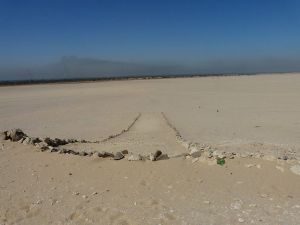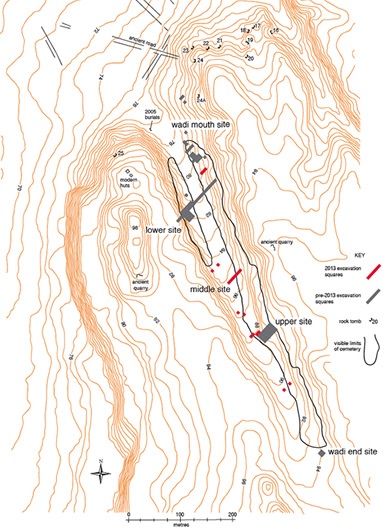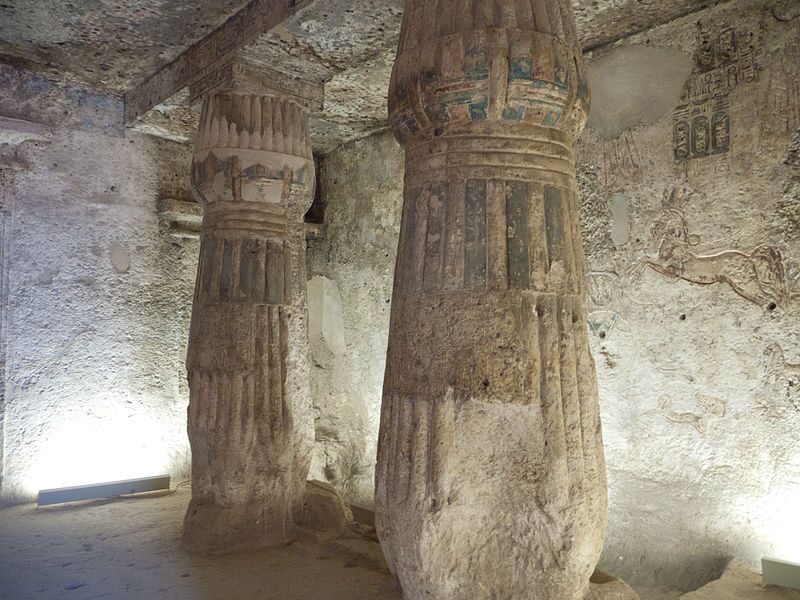
It remained a mystery for decades.
Since archaeologist F.Ll. Griffith’s excavations in the 1920’s at the ancient site of the pharaoh Akhenaten’s short-lived new capital city of Akhetaten (modern Amarna), archaeologists have been puzzled about the whereabouts of the remains of the city’s commoner population – the people who toiled to build and maintain Akhenaten’s sacred edifices and infrastructure — and more specifically, the estimated 6,000 people who died during the short 15-year period of the city’s construction and development.
“A will-of-the-wisp, the dream of a rich unplundered cemetery of the middle classes at El-Amarneh, full of choice vases and amulets, beckons to each successive explorer,” wrote Griffith in the report for his 1923 excavation season.*
Many of the elaborate unfinished rock-cut tombs of Akhenaten’s elite courtiers and high officials had already been found. They grace the cliff faces of the northern end of the Amarna city plain and the face of a low escarpment at the southern end of the ancient city. They can be plainly seen today by modern visitors.
But the burials of the deceased of the estimated 30,000 commoners and laborers remained elusive – until 2001, when archaeologist Barry Kemp of the University of Cambridge began to see the first signs. Kemp has directed excavations and surveys at Amarna for the Egypt Exploration Society since 1977.
“The puzzle seems now to have been solved,” says Kemp. “ It has come about through the desert GPS survey begun in 2001 and continued in subsequent years. First came the discovery of two cemeteries (clearly robbed) of what must be relatively poor graves on the flat desert not far from tomb no. 6 (of Panehesy), the southernmost of the North Tombs. The surface pottery is appropriate to the Amarna period. In 2003 a third cemetery was discovered on the east side of a narrow wadi which runs back into the low escarpment behind tomb 25 of the South Tombs group. In 2004 two further cemeteries likely to be of the Amarna Period were located on the floor of another wadi which cuts through the cliffs where the North Tombs are located.”**
_________________________________________
Project map of Akhetaten, showing locations of tomb areas and progress as of 2006. Courtesy the Amarna Project
_________________________________
Above: Plan of the South Tombs Cemetery showing excavation areas. Courtesy Helen Fenwick and the Amarna Project
_________________________________
View of the interior of the tomb of Panehesy. Mutnedjet, Wikimedia Commons
_______________________________
Most recently, from 2006 to 2013, Kemp’s excavation team has uncovered artifacts and bones from a cemetery site located near the South Tombs, a site where preliminary evidence indicated that it held the burials of a poorer class of people. “Of the various cemeteries located it is the one that has the most varied material present on the surface, including late 18th Dynasty sherds, a few pieces of glass vessel and faience, and mud bricks,” states Kemp and colleagues. But, Kemp continues, “it has been partly washed away by occasional floods that have swept down it and across the desert plain in front. The floods left behind a scatter of human bones along both the sandy floor of the wadi and the watercourses that cross the desert plain beyond.”**
Flooding hasn’t been the only challenge faced by researchers at the site. Extensive looting has taken its toll, resulting in additional bones and sherds scattered out of their original contexts across the site and creating urgent pressure to record what remains before it is lost.
Under the direction of Jerry Rose of the University of Arkansas, Project experts have been examining the skeletal remains. “Preliminary indications are that they lived hard, short lives,” reports Kemp and colleagues.** In 2015, examination of the skeletal remains will continue, and Kemp hopes to begin excavating at locations near the North Tomb.
The pharaoh Akhenaten, best known as the ‘heretic pharaoh’, employed thousands of workers and officials to build and administer the city of Akhetaten (Amarna) as his new capital on virgin land north of Thebes in Middle Egypt. Dedicated to the veneration of his new monotheistic religion of worship to the Aten, construction commenced in or around Year 5 of his reign (1346 BC) and is thought to have been completed by Year 9 (1341 BC). Unlike all other ancient Egyptian cities, it is the only one that preserved details of its internal plans. This city, however, was short-lived, lasting only 15 years until Akhenaten’s death. Akhenaten’s son Tutankhamun moved the capital back to Thebes upon his father’s death and returned Egyptian worship to its former pantheon of gods.
More information about the Amarna Project can be obtained at the website, where individuals may also find a utility to donate to support the project efforts. Those interested in participating in the project may also visit the applicable University of Arkansas website.
__________________________________________
* JEA 10, 1924, 303-304.
** http://www.amarnaproject.com/
Cover Image, Top Left: View of the South Tomb area at Amarna. Kurohito, Wikimedia Commons
__________________________________________
Read about the most fascinating discoveries with a premium subscription to Popular Archaeology Magazine. Find out what Popular Archaeology Magazine is all about. AND MORE:
On the go? Get the smartphone version of Popular Archaeology as an app or as an ebook.
Popular Archaeology’s annual Discovery Edition eBook is a selection of the best stories published in Popular Archaeology Magazine in past issues, with an emphasis on some of the most significant, groundbreaking, or fascinating discoveries in the fields of archaeology and paleoanthropology and related fields. At least some of the articles have been updated or revised specifically for the Discovery edition. We can confidently say that there is no other single issue of an archaeology-related magazine, paper print or online, that contains as much major feature article content as this one. The latest issue, volume 2, has just been released. Go to the Discovery edition page for more information.








